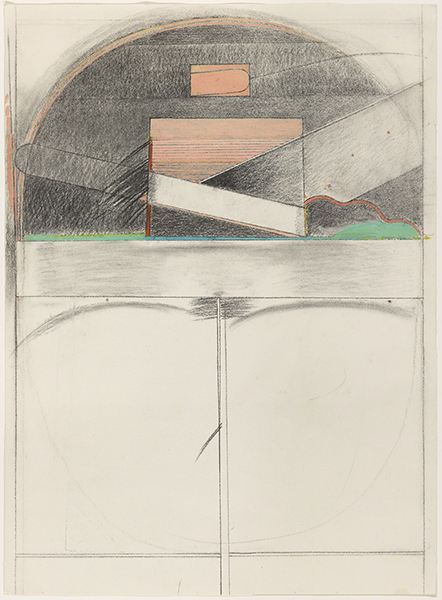AAPI Heritage Month 2023: Miyoko Ito
Let’s recognize a true original in Chicago abstract painting to celebrate Asian American and Pacific Islander Heritage month: Miyoko Ito. There were two strains in painting that characterized the Chicago School during the 1970s and 1980s. One, aligned with Pop Art, was figurative and based largely on comic art and advertising. The other, to which Ito belonged, was a vibrant group of abstractionists who painted in a broad range of styles from organic to geometric abstraction, characterized by both Minimalist and Expressionist tendencies.
 |
| Miyoko Ito (1918–1983, U.S.), Untitled, ca. 1975. Charcoal and semi-gloss opaque paint (possibly oil) on paper, sheet: 29 15/16" x 22" (76 × 55.9 cm). Image courtesy of the Philadelphia Museum of Art. © 2023 Artist or Estate of Artist. (PMA-8679) |
Ito's work of the 1970s and 1980s is often characterized by high-value, carefully aligned closed shapes based loosely on geometry. In this untitled work, the nuances in tone give an overall lyrical quality to the composition, while there is an allusion to depth. The shifting shapes of Pablo Picasso's early Analytical Cubism are definitely at play in the upper part of this composition. The suggestive, untouched areas of the work may suggest the sketchy compositions of Henri Matisse, but the tight organization of forms into a mostly closed composition are typical of Ito's abstractions.
Ito was tangentially associated with the Chicago Imagists who formed in the mid-1960s. The Imagists—primarily figurative artists—were graduates of the School of the Art Institute who thumbed their noses at the professional “art world” of New York. This monetized art world in New York meant that Abstract Expressionism and nonobjective offshoots such as post-painterly abstraction and Color Field thrived commercially. Other groups evolved in the 1970s that featured combinations of abstraction and Surrealism, a more lyrical abstraction than that of Abstract Expressionism and its offshoots.
The daughter of Japanese immigrants who settled in Berkeley, California, in 1914, Ito returned to Japan with her mother in 1923. There she studied calligraphy, composition, and Japanese culture. When her family returned to the U.S. in 1928, she went to school in Berkeley, benefiting from an excellent art department. Viewing a large-scale Picasso exhibit in 1939 and learning about European modernism led the work of Picasso and Matisse to have a lasting impact on Ito. In a 1978 interview, Ito announced that she was very much a “Matisse and Picasso” person.
Attending the University of California, Berkeley, Ito studied art and became part of a group of painters known as the “Corps of Serious Painters.” While there, she was greatly influenced by the abstractions of Hans Hofmann (1880–1966), who was invited to California in the 1930s by one of her teachers. In April 1942, Ito and her husband were interned in a concentration camp for people of Japanese heritage near San Francisco. Despite being forced to leave shortly before graduation, Ito earned her degree with honors from Berkeley.
Ito accepted a scholarship to Smith College in Northampton, Massachusetts, for graduate work, which allowed her to leave the concentration camp. While there, she was impressed with the expressionistic abstractions of Rufino Tamayo (1899–1991), who painted a mural there. Since Smith College had no studio art department, she left when she received a scholarship to attend the School of the Art Institute of Chicago.
While at the School of the Art Institute, Ito was exposed to many former Bauhaus teacher-artists. Their constructivist, geometric abstractions inspired an interest in architectonic forms in her paintings. Until 1948, she worked primarily in watercolor, adapting printmaking and painting in oils later. Although at the time Abstract Expressionist action painting was popular, Ito’s forms became increasingly closed compositions.
Raising a family confined Ito to domestic duties in the 1950s. By the 1960s, she became more social with other artists and her career expanded from that time. In 1981, Ito co-founded “Allusive Abstractionists,” a lyrical abstraction group in Chicago.
Correlations to Davis programs: The Visual Experience 4E: 4.3; Discovering Drawing 3E: Chapter 9; Experience Painting: Chapter 3; Exploring Painting 3E: Chapter 12; Explorations in Art 2E Grade 4: 6.7


Comments